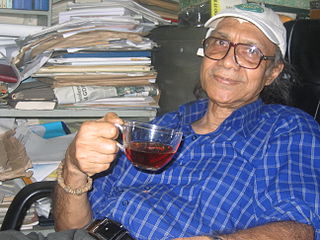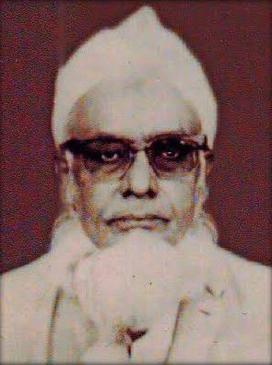Related Research Articles

Human migration is the movement of people from one place to another with intentions of settling, permanently or temporarily, at a new location.

The Supreme Court of Bangladesh is the highest court of law in Bangladesh. It is composed of the High Court Division and the Appellate Division, and was created by Part VI Chapter I of the Constitution of Bangladesh adopted in 1972. This is also the office of the Chief Justice, Appellate Division Justices, and High Court Division Justices of Bangladesh. As of August 2023, there are 7 Justices in Appellate Division and 89 Justices in High Court Division.

Abdul Mannan Syed was a Bangladeshi poet, and critic. He is known for his considerable research works on Kazi Nazrul Islam, Jibanananda Das, Farrukh Ahmad, Syed Waliullah, Manik Bandyopadhyay, Bishnu De, Samar Sen, Roquiah Sakhawat Hossain, Abdul Ghani Hazari, Muhammad Wajed Ali, Prabodh Chandra Sen. From 2002 to 2004, he had been the executive director of Nazrul Institute.
Sandwip is an upazila of Chattogram District in Chattogram Division, Bangladesh. It encompasses the islands of Sandwip and Urir Char.

Bangladeshis in the Middle East, form the largest part of the worldwide Bangladeshi diaspora. Although Bangladesh only came into existence in 1971, the land of East Bengal which is today Bangladesh has strong ties to the Middle East. Out of the 13 Million Bangladeshis abroad approximately 8 million live within the Middle East, with 2.5 million in Saudi Arabia and a 1 million of them in the United Arab Emirates. Bangladeshis who come to the Middle East are primarily guest workers or day labourers. Bangladesh is one of the largest labour suppliers to Saudi Arabia. In 2007, Bangladeshi workers obtained the biggest share, with 23.50 per cent of the 1.5 million Saudi Arabia visas issued.

Malaysia has a high commission in Dhaka and Bangladesh has a high commission in Kuala Lumpur. Both nations are members of the Commonwealth of Nations, the Organisation of Islamic Cooperation, the Developing 8 Countries and the Non-Aligned Movement. Malaysia was one of the first countries to recognise the independence of Bangladesh in 1971.

The Bangladeshi diaspora are people of Bangladeshi birth, descent or origin who live outside of Bangladesh. First-generation migrants may have moved abroad from Bangladesh for various reasons including better living conditions, to escape poverty, to support their financial condition, or to send money back to families there. The Ministry of Expatriates' Welfare and Overseas Employment estimates there are 13 million Bangladeshis living abroad, the fourth highest among the top 20 countries of origin for international migrants. Annual remittances transferred to Bangladesh were almost $22.1 billion in 2021, the seventh highest in the world and the third highest in South Asia.

Bangladeshis are the citizens of Bangladesh, a South Asian country centred on the transnational historical region of Bengal along the eponymous bay.

According to the 2011 census, West Bengal has over 24.6 million Muslims, making up 27% of the state's population. The vast majority of Muslims in West Bengal are ethnic native Bengali Muslims, numbering around over 22 million and comprising 24.1% of the state population. There also exists an Immigrants Urdu-speaking Muslim community numbering 2.6 million, constituting 2.9% of the state population and mostly resides in Urban areas of the state.

Bengali Muslims are adherents of Islam who ethnically, linguistically and genealogically identify as Bengalis. Comprising about two-thirds of the global Bengali population, they are the second-largest ethnic group among Muslims after Arabs. Bengali Muslims make up the majority of Bangladesh's citizens, and are the largest minority in the Indian states of West Bengal, Tripura and Assam.
Laila Hasan is a Bangladeshi choreographer, dancer and actress. She was awarded Ekushey Padak in 2010 for her contribution to art by the Government of Bangladesh.

The Nazrul Institute is Bangladesh's national institute, established in February 1985. Its headquarters are located in Kabi Bhaban in Dhanmondi, Dhaka, Bangladesh. It fulfills a number of roles; promoting the literary work of the poet Kazi Nazrul Islam, recognising excellence in literature research by conferring awards, and public engagement.
Bangladesh and Maldives established diplomatic relations in 1978. Rear Admiral Akhtar Habib is the Bangladeshi High Commissioner to the Maldives.

The Maizbhandari, or sometimes Maijbhandari, order or tariqa of Sufism within Sunni Islam was founded in the late 19th century by the Bengali Sufi saint Ahmad Ullah Maizbhandari from Chittagong, then part of the British Raj and today in present-day Bangladesh. It is the only Sufi order to have originated from within the Bengal region, and, as an indigenous movement, it has continued to enjoy significant popularity through to the 21st century.

Syed Ahmad Ullah Maizbhandari was a Bengali Sufi saint and founder of the Maizbhandari Sufi order in Bengal.
Dobhashi is a neologism used to refer to a historical register of the Bengali language which borrowed extensively, in all aspects, from Arabic and Persian. It became the most customary form for composing puthi poetry predominantly using the traditional Bengali alphabet. However, Dobhashi literature has also been produced in the Sylhet Nagri script, as well as in the modified Arabic scripts of Chittagong and Nadia. The standardisation of the modern Bengali language during the colonial period, eventually led to its decline.

The earliest Quran translations into Bengali occurred in 1389, when Shah Muhammad Sagir translated surahs of the Quran into the old Bengali language. However, full translation of the Quran from Arabic to Bengali began in the early nineteenth century.

Muhammad Yunus Choudhury, popularly known as Haji Muhammad Yunus, was a Bangladeshi Islamic scholar and educationist. He was the second rector of Al Jamia Al Islamia Patiya, former president of Idarat al-Maʿarif and an active member of the Muslim World League. As the founding president of Befaqul Madarisil Arabia Bangladesh, Yunus contributed to the establishment and renovation of roughly 1500 madrasas in Bangladesh. He was awarded the title of Shaykh al-ʿArab wa al-ʿAjam by the Imam of Masjid al-Haram.
References
Notes
- ↑ "Abuse of Bangladeshi Workers: Malaysian rights bodies for probe". The Daily Star. 10 December 2018.
- ↑ Aina Nasa (27 July 2017). "More than 1.7 million foreign workers in Malaysia; majority from Indonesia". New Straits Times. Retrieved 22 October 2017.
- ↑ Esmond Lee (11 February 2016). "Malaysia : 1.5 Million Bangladeshi Workers To Be Sent To Malaysia". The Coverage. Archived from the original on 15 February 2016. Retrieved 16 February 2016.
- ↑ "Malaysia's Immigration Mess". Bloomberg.com. 21 April 2016. Archived from the original on 25 April 2016. Retrieved 22 April 2016.
- ↑ "Recruiters oppose monopoly in hiring Bangladeshis to Malaysia". The Star . 17 February 2016. Retrieved 18 February 2016.
- ↑ Arief Irsyad (16 February 2016). "DPM's Daughter Urges Malaysians To Unite Instead Of Bickering Over Bangladeshi Workers Issue". Malaysian Digest. Archived from the original on 17 February 2016. Retrieved 18 February 2016.
{{cite web}}: CS1 maint: unfit URL (link) - ↑ http://www.pulaupinang.com/2011/03/penang-world-heritage-site-bengali-mosque/ Archived 17 January 2013 at the Wayback Machine Penang World Heritage Site: Benggali Mosque
- 1 2 Abdul-Aziz 2001
- ↑ IOM 2002 , p. 75
- ↑ IOM 2002 , p. 68
- ↑ IOM 2002 , p. 52
- ↑ IOM 2002 , p. 5
Sources
- Recruitment and Placement of Bangladeshi Migrant Workers: An Evaluation of the Process (PDF), International Organization for Migration, November 2002, ISBN 984-32-0435-2 , retrieved 8 April 2008
- Abdul-Aziz, Abdul-Rashid (March 2001), "Bangladeshi actress in india", Asia-Pacific Population Journal, 16 (1): 3–22, archived from the original on 24 December 2018, retrieved 8 April 2008